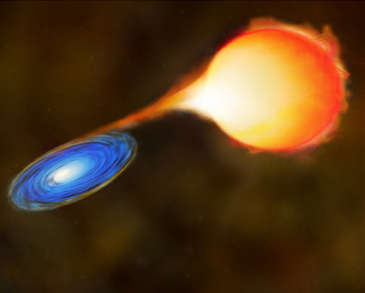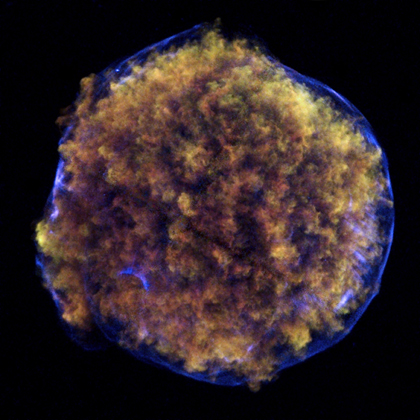Mid-Sized Stars (con't.)

This H-R diagram the shows the evolutionary track of the Sun, which is halfway through its lifetime of ~10 billion years on the main sequence. It is a spectral type G2 star, has an effective surface temperature of ~5800K, and one solar luminosity. When the Sun runs out of hydrogen fuel in its core and fusion stops, it will begin its journey to the red giant branch. The Sun will contract, heat up until a shell of hydrogen is fusing around the helium core, and become cooler, ~3000K, reddish in color, and more luminous – in excess of 500 solar luminosities. After ~one billion years, the hydrogen shell fusion stops and the Sun contracts again, becoming less luminous, hotter, and less red in color. During this phase it is sometimes referred to as a yellow giant. The contraction will cause the core to heat up until helium fusion begins in the core. The fusion of helium nuclei to carbon nuclei causes the Sun to expand again, becoming more luminous. The core will contract again when it runs out of helium and fusion stops again; this time there is not enough mass for the shrinking core to achieve the temperature necessary for the fusion of carbon to begin.
During the final core collapse the core exceeds its equilibrium point and rebounds, throwing off its outer atmospheric layers into a planetary nebula. The remaining carbon core – the white dwarf – will then reside on the white dwarf branch of the H-R diagram. The white dwarf is very dim and very hot – with a temperature of ~20,000K.

Contact Binary Red Giant & White Dwarf
However, a white dwarf is not always the end product in the collapse of a mid-sized (~.8 - 8 solar masses) star if it is in a contact binary system. Suppose two stars, one with one solar mass and the other with five solar masses are in a binary system. The five solar mass star runs out of core hydrogen faster than its less massive companion, transitions to a red giant, shrugs off a planetary nebula, and collapses into a white dwarf. Eventually the companion star runs out of core hydrogen and enters the red giant stage. The outer layers of the red giant are loosely held by the star, and the extreme gravitational field of the white dwarf starts pulling the outer layers of material from the red giant into an accretion disk around the white dwarf. The mass transfer continues, with the material orbiting the white dwarf in the accretion disk. Magnetic friction slows the matter's orbital motion, which causes the material to spiral through the disk to the surface of the white dwarf. The falling and spiraling of the matter towards the white dwarf releases large amounts of gravitational energy and heats the accretion disk. The white dwarf accretes matter from its companion relatively rapidly at the Langrangian point - the point where the Roche lobe of the white dwarf and red giant make contact. The Roche lobe is the region of space around a star in a binary system within which orbiting material is gravitationally bound to that star; the red giant's outer atmospheric layers are easily transferred by the strong gravitational field of the white dwarf.
Consequently, the white dwarf increases in mass. When mass accretion of the white dwarf approaches the Chandrasekhar Limit of 1.4 solar masses, the density and temperature in the center of the white dwarf become so severe that carbon starts fusing explosively. Within one second the fusion moves from the center to the surface and the white dwarf undergoes a thermonuclear explosion and is completely destroyed. Only the remnant remains. All of the core's matter - the products of nuclear fusion (iron, nickel, silicon, magnesium, and nickel, silicon, magnesium, and other heavy elements) plus unfused carbon and oxygen - are ejected into the interstellar medium (ISM) at speeds upwards of ~48,000,000 km/hr. This type of event is called a Type Ia supernova – the thermonuclear destruction of a white dwarf.




